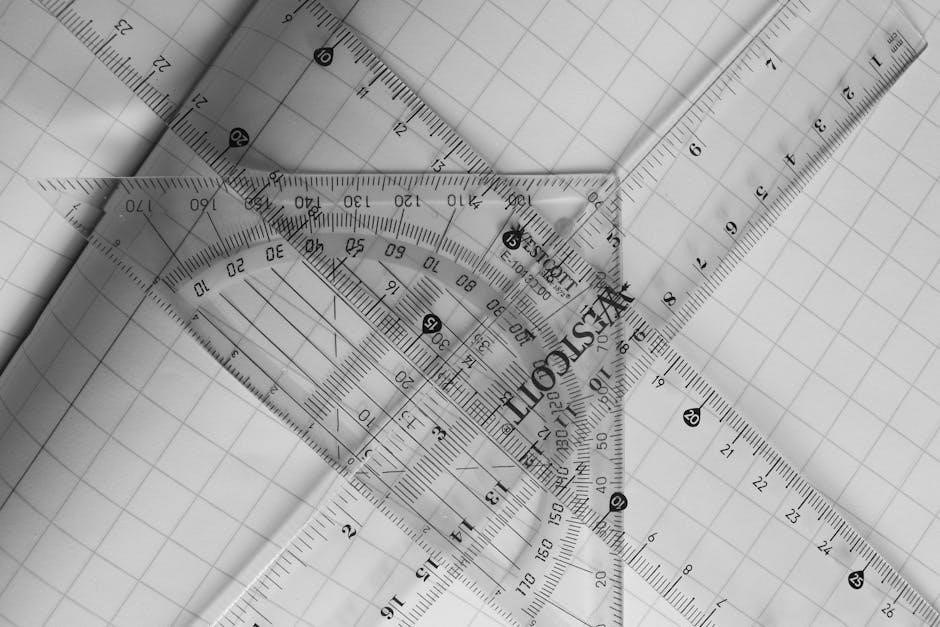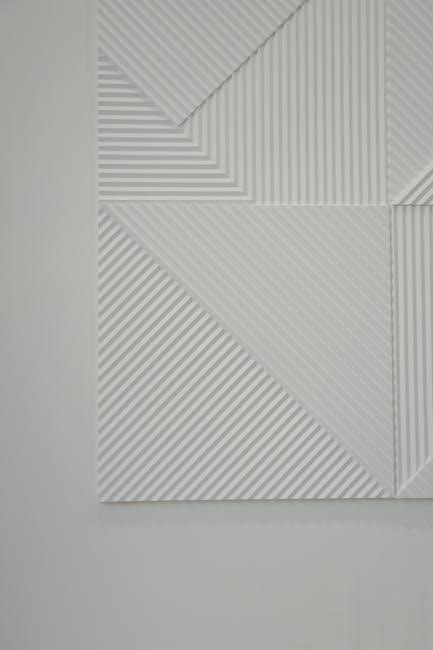Angles in a triangle are fundamental geometric concepts, always summing to 180 degrees. Understanding them is crucial for classifying triangles and solving various geometric problems effectively.
1.1 Definition of Angles in a Triangle
In a triangle, an angle is formed by two sides meeting at a vertex. Angles are measured in degrees, ranging from 0° to 180°. Triangles have three interior angles, which can be acute (less than 90°), right (90°), or obtuse (greater than 90°). The sum of these angles is always 180°, as stated by the Triangle Angle-Sum Theorem. Understanding these definitions is essential for analyzing and solving geometric problems involving triangles.
1.2 Importance of Understanding Triangle Angles
Understanding triangle angles is crucial for applying geometric principles effectively. It aids in classifying triangles into acute, right, or obtuse, which is essential for solving problems in construction, physics, and engineering. Knowledge of angles enables the use of theorems like the Triangle Angle-Sum Theorem and Exterior Angle Theorem. This understanding also facilitates calculating unknown angles and sides, making it fundamental for advanced geometric and real-world applications.

Triangle Angle-Sum Theorem
The Triangle Angle-Sum Theorem states that the sum of the interior angles in any triangle is always 180 degrees, a fundamental geometric principle.
2.1 Statement of the Theorem
The Triangle Angle-Sum Theorem states that the sum of the interior angles in any triangle is always 180 degrees. This fundamental principle applies universally to all triangles, whether they are acute, right, or obtuse. Knowing the measures of two angles allows the third to be calculated, making this theorem essential for solving geometric problems and understanding triangle properties.
2.2 Proof and Examples
The proof of the Triangle Angle-Sum Theorem involves extending one side of the triangle to form a straight line (180 degrees). By understanding supplementary angles and parallel lines, it is shown that the sum of the triangle’s interior angles equals 180 degrees. Example 1: In a triangle with angles 60° and 90°, the third angle is 30° (180 ― 60, 90). Example 2: If two angles are 50° and 70°, the third angle is 60° (180 ― 50, 70). These examples demonstrate the theorem’s practical application in solving geometric problems.

Exterior Angle Theorem
The exterior angle of a triangle equals the sum of the two non-adjacent interior angles, providing a useful tool for solving geometric problems efficiently.
3.1 Relationship Between Exterior and Interior Angles
The exterior angle of a triangle is equal to the sum of the two remote interior angles. This relationship, known as the Exterior Angle Theorem, is derived from the fact that the sum of all interior angles in a triangle is 180 degrees. By understanding this connection, students can solve for unknown angles and verify the consistency of triangle angle measures in various geometric problems.
3.2 Applications of the Exterior Angle Theorem
The Exterior Angle Theorem is widely used to solve for unknown angles in triangles and verify geometric properties. It aids in constructing triangles with specific angle measures and analyzing relationships in polygonal figures. This theorem is also applied in real-world problems, such as calculating angles in architectural designs or engineering structures, making it a versatile tool in geometry and its practical applications.

Classifying Triangles by Angles
Triangles are classified by their angles as acute, right, or obtuse. Special cases include equilateral and isosceles triangles, each with unique angle properties.
4.1 Acute, Right, and Obtuse Triangles
A triangle is classified by its angles: acute if all angles are less than 90°, right if one angle is exactly 90°, and obtuse if one angle exceeds 90°. These classifications help in understanding geometric properties and real-world applications, such as in construction and physics, where angle measurements are critical for structural integrity and motion analysis.
4.2 Special Cases: Equilateral and Isosceles Triangles
An equilateral triangle has all three sides and angles equal, each measuring 60°, offering maximum symmetry. An isosceles triangle has two equal sides and two equal angles, with the third angle different. These special cases simplify calculations and appear frequently in geometric proofs and real-world applications, such as in architecture and engineering, where symmetry and balance are essential.

Intervention Strategies for Mastering Triangle Angles
Use targeted worksheets and real-world applications to reinforce angle concepts, ensuring a strong foundation for advanced geometric problem-solving and practical scenarios.
5.1 Skills Practice Worksheets
Skills practice worksheets are essential for reinforcing triangle angle concepts. They provide structured exercises, such as finding missing angles and applying theorems. These worksheets include problems like calculating third angles when two are known and verifying the exterior angle theorem. Examples from the internet include exercises with specific measures, such as finding angles in triangles with given sides or applying the angle-sum theorem. Regular practice helps students master geometric principles and build problem-solving confidence.
5.2 Real-World Applications of Triangle Angle Concepts
Triangle angle concepts are vital in various real-world applications, such as construction, engineering, and physics. Architects use triangle properties to design stable structures, while engineers apply angle theorems in bridge building and machinery. In physics, triangle angles aid in calculating forces and trajectories. These practical uses demonstrate how understanding triangle angles is essential for solving real-world problems and innovating in multiple fields.

Interactive Activities for Learning
Interactive activities, such as constructing triangles with specific angles and using digital tools, engage students in hands-on learning, enhancing their understanding of triangle properties and angle relationships.
6.1 Constructing Triangles with Specific Angle Measures
Constructing triangles with specific angle measures helps students visualize geometric properties. Using tools like protractors, students can create triangles with desired angles, such as 30°, 60°, or 90°, and explore relationships between angles and sides. This hands-on activity reinforces understanding of angle-sum theorems and exterior angle properties. By arranging interior angles to match exterior ones, students gain practical insights into triangle geometry, making abstract concepts more tangible and easier to grasp.
6.2 Using Technology to Explore Triangle Properties
Technology enhances learning through interactive tools like geometric software and online simulators. Students can explore triangle properties dynamically, such as manipulating angles to observe side length changes. Virtual labs allow safe experimentation, while 3D modeling provides deeper insights into spatial relationships. These tools cater to diverse learning styles, offering visual and kinesthetic approaches. They also provide immediate feedback, reinforcing concepts like angle-sum and exterior angle theorems, making complex ideas more accessible and engaging for students.

Common Misconceptions and Solutions
A common misconception is confusing interior and exterior angles. Clarify that exterior angles equal the sum of the two opposite interior angles, aiding in problem-solving accuracy.
7.1 Misunderstandings About Angle Sums
A common misunderstanding is believing the sum of triangle angles varies. However, the sum is always 180 degrees. Some students may think it equals 90 degrees, confusing it with right angles. Emphasize that each angle’s measure impacts the others, ensuring the total remains constant. This clarity helps in accurately solving problems involving unknown angles in triangles.
7.2 Clarifying the Difference Between Interior and Exterior Angles
Interior angles are those inside the triangle, while exterior angles are formed by one side and the extension of another. A common confusion is the relationship between them. The exterior angle equals the sum of the two non-adjacent interior angles. Clarifying this distinction helps avoid errors in calculations and ensures a proper understanding of triangle properties and theorems related to their angles.

Advanced Topics in Triangle Angle Geometry
Exploring beyond basics, this section introduces the Law of Sines and Cosines, linking angles with side lengths, and advanced triangle angle properties in complex geometric figures.
8.1 The Law of Sines and Cosines
The Law of Sines relates the sides and angles of a triangle, stating that the ratio of each side to the sine of its opposite angle is constant. The Law of Cosines extends this, allowing calculation of a side when two sides and the included angle are known. These laws are essential for solving non-right triangles and understanding complex geometric relationships, proving invaluable in advanced triangle analysis and real-world applications.
8.2 Triangle Angle Properties in Different Geometric Figures
Triangle angle properties extend beyond individual triangles, influencing larger geometric figures. In parallelograms, for instance, triangle angles formed by diagonals reveal relationships between opposite and adjacent angles. Similarly, in polygons and 3D figures like pyramids, understanding triangle angles aids in analyzing overall shape properties. These connections highlight the foundational role of triangle angle principles in broader geometric analysis, emphasizing their importance in advanced studies and real-world applications.

Assessment and Review
Evaluate understanding with quizzes and summaries, ensuring mastery of triangle angle concepts through targeted exercises and reviews.
9.1 Quiz Questions to Test Understanding
Assess knowledge with targeted quiz questions covering angle sums, exterior angles, and triangle classification. Include multiple-choice, fill-in-the-blank, and true/false questions. Example: “If two angles of a triangle are 60° and 70°, find the third.” or “Is the triangle acute, right, or obtuse?” Ensure questions address theorem applications and angle relationships, promoting critical thinking and retention of key concepts.
9.2 Review of Key Concepts and Theorems
Recap essential concepts, including the triangle angle-sum theorem and exterior angle theorem. Emphasize the relationship between interior and exterior angles. Highlight the importance of classifying triangles as acute, right, or obtuse. Reinforce theorems with examples, ensuring clarity on how angles interact within triangles. This review solidifies foundational knowledge, preparing students to apply these principles in solving problems and exploring more advanced geometric topics.
Mastering triangle angles is foundational for geometry. This guide covered key theorems, classifications, and practical applications. Continue exploring to deepen your understanding and problem-solving skills in trigonometry;
10.1 Summary of Key Takeaways
Understanding triangle angles is crucial for solving geometric problems. The angle-sum theorem states that a triangle’s angles sum to 180 degrees. Classifying triangles into acute, right, or obtuse helps in analyzing their properties. The exterior angle theorem highlights the relationship between exterior and remote interior angles. Practical applications in real-world scenarios, such as construction and engineering, emphasize the importance of mastering these concepts. Regular practice and interactive activities reinforce learning and problem-solving skills effectively.
10.2 Encouragement for Further Study
Exploring advanced geometric concepts, such as the Law of Sines and Cosines, can deepen your understanding of triangle angles. Applying these principles to real-world problems in engineering or architecture can highlight their practical significance. Persistent practice and curiosity will enhance your problem-solving skills and open doors to more complex mathematical discoveries. Embrace challenges and continue building a strong foundation in geometry for future academic and professional endeavors.

No Responses